Ants can be quite difficult to identify as there are more than 700 species in the United States alone. The good news is that there are some unique characteristics and behavioral traits that can distinguish them from one another.
So, how many types of ants are there? The most common ant species that can invade your home and property are the following:
- Red Imported Fire Ants
- Carpenter Ants
- Crazy Ants
- Acrobat Ants
- Pharaoh Ants
- Odorous House Ants
- Leaf-Cutting Ants
- Rover Ants
- Pavement Ants
These types of ants can be seen with naked eye, so if you learn about their characteristics, you’ll be able to recognize their type within seconds and learn how to successfully remove them. Read further for more!
Body Characteristics of Ants
When observed through the microscope it’s easy to see why some people are afraid of them. Like most insects, ants also have 3 body regions. The difference is that ants have very distinct regions, making them easy to recognize.

Ant’s body consists of these three regions as seen on the illustration above. Gaster is a rear part, the thorax is in the middle, and the head is at the end of its body with an antenna on top of their heads. Gaster and thorax, are connected by two small segments called nodes or pedicels.
Workers, as the most abundant members of the colony, don’t have wings, while ants responsible for reproduction may have them. Reproductive ants are also much bigger than workers and they usually command the colony. They can also leave the nest for mating purposes a few times a year.
Ant Nests & Behavior
Usually, ants make their nest in the soil or under the rock, and they make several entrances in case the nest gets compromised. Some species build nests in trees, without creating cavities, while other ants don’t make nests at all.
In terms of behavior, ants are easily distinguished. When someone says you’re working like an ant, that’s a very valuable compliment. Ants are known as being hard workers, as well as having incredible strength.
If the workers are equal in size in a colony, this is referred to as a monomorphic colony, as opposed to the polymorphic colony, when the workers are of different sizes.
Types of Ants: How to Identify Them?
Below are the descriptions and pictures of each common type of ant (ant identification chart), this will make it easy for you to determine what type of ant you’re dealing with.
Carpenter Ants
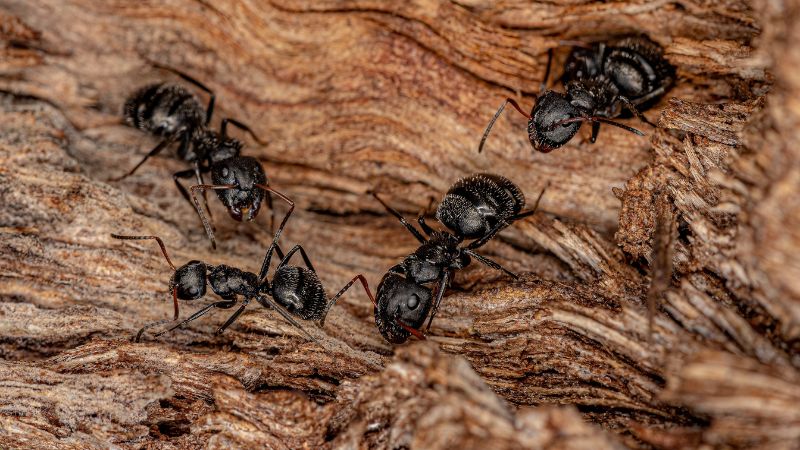
Carpenter ants (Campanotus spp.) are one of the most common types of ants in the United States with 60 recorded species. They can usually be found in colder climates such as in the northern part of the country.
- Identification: Large ants about ¼ to ½ inch in size. They are brown, solid black, or a combination of reddish orange and black in color. They are identifiable by their single pedicel and curved thorax.
- Nesting Site: Different wood sources, usually in hollow trunks and tree branches but can also be found in hollow walls, ceilings, and doors of buildings
- Behavior: Active during the night and are usually seen following linear trails such as fences or water hoses. They can bite but can’t sting and can cause a good amount of property damage.
- Control: Insecticide spray or dust as well as repair or replace damaged roofs, leaked windows or vents, and decayed or softened wood.
Red Imported Fire Ants
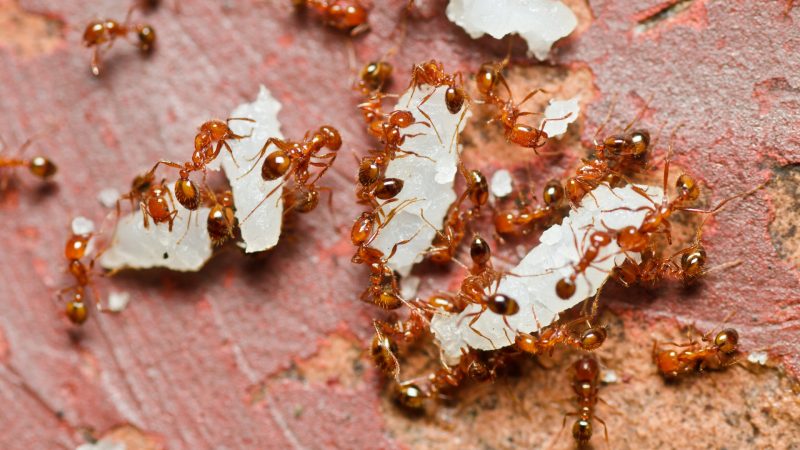
Red imported fire ants (Solenopsis invicta) are usually found in Southeastern United States such as in Texas, Maryland, New Mexico, and California. These red ants are common invaders of residential and commercial areas.
- Identification: Relatively small ants that are 1/16 to 3/16 in length. They are uniquely reddish brown in color and have 2 pedicels.
- Nesting Site: Visible, dome-shaped mounds with no visible entrances and holes usually found outside in soil near landscaping or structural foundations.
- Behavior: Resorts to aggressive behavior as a response to nest disturbance. They can deliver painful stings that leave red welts on the skin.
- Control: Fire ant baits applied in the evening during hot weather. Baits should preferably contain an insect growth regulator or corn-grit bait for the best results.
Crazy Ants
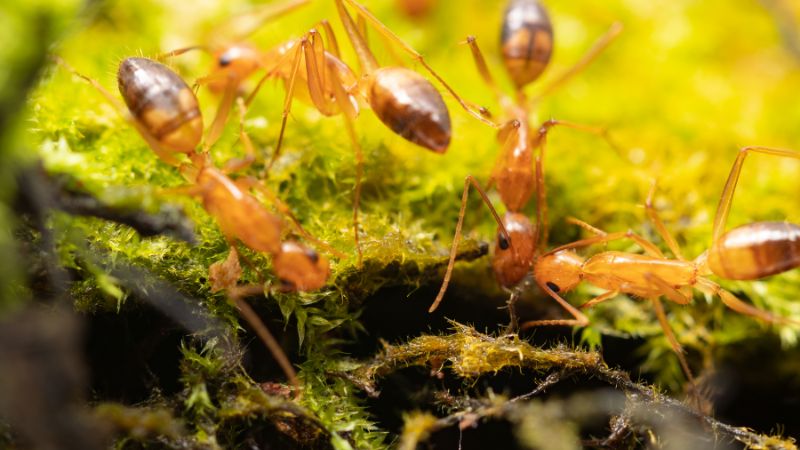
Crazy ants (Paratrechina spp. and Nylanderia spp.) are called like that for a reason. They can become quite persistent pests when they’ve successfully established a colony indoors. These types of ants cannot survive northern climates.
- Identification: Medium-sized ants that are 1/16 to ⅛ in length. They are particularly hairy, has long legs, and are dark brown, light brown, or black in color.
- Nesting Site: In buildings, specifically under the floor or carpets when humidity is high but they also construct nests in potted plant soil, rotten wood, and tree cavities.
- Behavior: Extremely fast moving especially when foraging for food. They have erratic behaviors that make no sense of direction. Although they aren’t dangerous to human health, they can still sting.
- Control: Using granular baits made for carpenter ants and applying them during the late winter to early spring seasons. Outdoor insecticidal spraying is also recommended.
Acrobat Ants
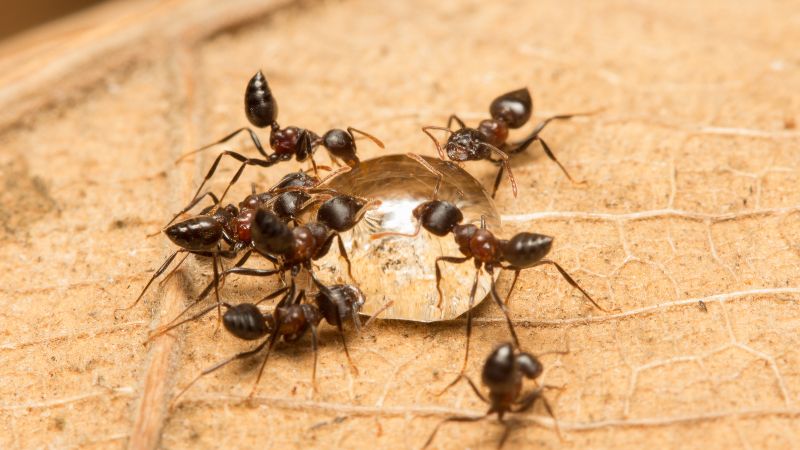
Acrobat ants (Crematogaster spp.) get their names from the fact that they lift their gasters when disturbed, forming a defensive posture similar to an acrobat balancing on their hands. They’re commonly mistaken for carpenter ants.
- Identification: Medium-sized ants that are 1/16 to ⅙ inch in length. They have two pedicels and two spines on their thorax.
- Nesting Site: In trees and decaying or dead wood but they can also be seen in structural insulation and building walls.
- Behavior: This species is extremely territorial and are one of the most dominant arboreal ants. They cause minimum damage to homes but their presence can still be quite the nuisance.
- Control: Applying insecticidal spray or dust into wall voids that are infested. Another way is to reduce entry to homes by sealing cracks in exteriors.
Pharaoh Ants
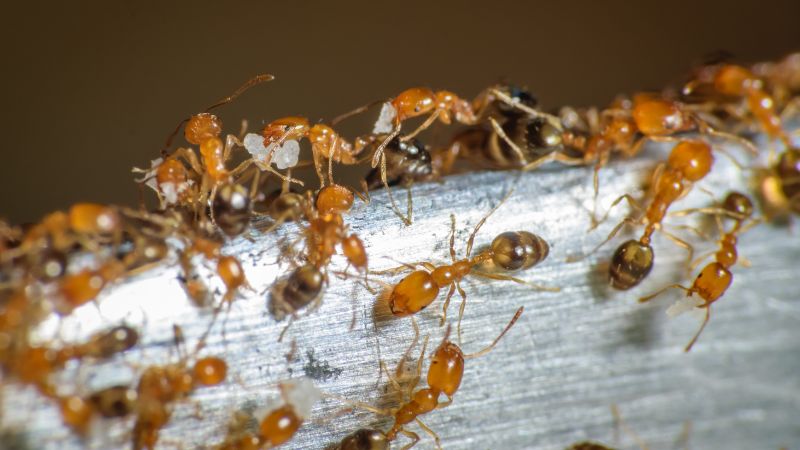
Pharaoh ants (Monomorium pharaonis) acquired their name possibly from the misconception that they have caused the plagues in ancient Egypt. Today, this species is a common household ant and may very well be the most difficult to manage.
- Identification: Extremely tiny ants that are only 1/32 inch in length. They are yellow with a dark brown gaster and have two pedicels.
- Nesting Site: In areas that are warm, humid, and dark or inaccessible such as wall voids, cardboard boxes, electrical boxes, and the like.
- Behavior: This species is particularly hard to manage since their colonies have the habit to split or bud (i.e., create new colonies) even in the absence of a queen.
- Control: Setting up non-repellent ant baits in all of its nests, including daughter colonies. For indoor infestations, insect growth regulators are recommended.
Odorous House Ant

Odorous house ants (Tapinoma sessile) are found in every part of the country, regardless of climate, moisture, and other environmental factors. When crushed, they give off a specific odor that smells like rotten coconut or licorice, depending on who you ask.
- Identification: Medium-sized ants that are between 1/16 to ⅛ in length. They are dark brown but can occasionally be black in color.
- Nesting Site: Indoors, they nest inside wall voids or under floors while outdoors, they construct colonies under mulch, exposed soil, or stones.
- Behavior: They forage both in day and night as they follow pheromone trails established by other ants. They usually establish new colonies starting late spring or early summer.
- Control: Find their nests and treat it with a liquid ant control product or an aerosol. For indoor control, set up a sugar-based ant bait.
Leafcutter Ant

Leaf-cutting ants (Atta texanus) are one of the largest ants and are easily identifiable due to their size. They are known for their leaf-carrying behavior and distinguishable, crater-shaped nests that form in clusters resembling “towns.”
- Identification: Large ants that are anywhere from 1/16 to ½ inch in length. They have long legs, three spines on their thorax, and a smooth gaster. Additionally, they are mostly brown in color with some red accents.
- Nesting Site: In backyards, specifically under soil or grass
- Behavior: These ants carry back leaves and other plant materials back to their nests to grow a special type of fungus, which is the food source for this species and their colonies.
- Control: Insecticidal dust or granules but with frequent reapplications due to the ants’ size and complexity of their nests. Additionally, ant bait is also recommended.
Rover Ant
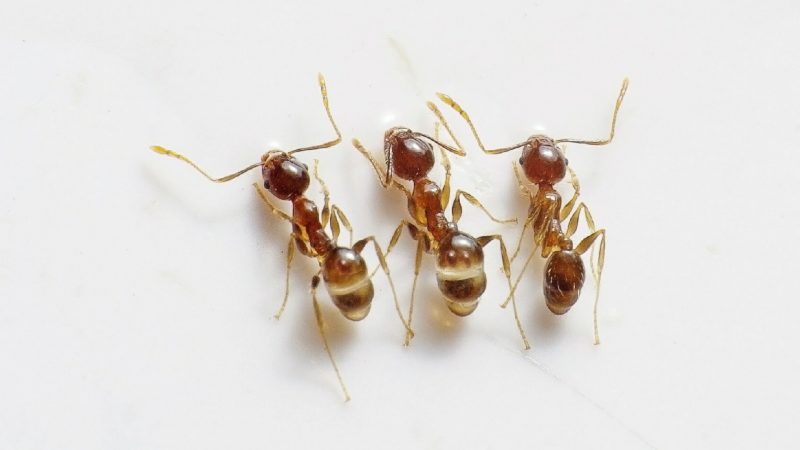
Rover ants (Brachymyrmex patagonicus) were not particularly considered as pests until in 2015 when they have become more prevalent through some states such as Texas. However, they are not known to sting so they are not of medical concern.
- Identification: Tiny ants that are only about 1/16 inches in size. They vary in color from dark brown, black, to pale blonde. They also have an uneven thorax and a humped front.
- Nesting Site: Usually found in rotting wood or soil but they can also construct them in wall voids and potted plants.
- Behavior: Although they don’t sting, they still enter homes to find sugary food items that they can consume and bring back to their colonies.
- Control: Since this species is not attracted to granular or liquid ant baits, non-chemical and cultural controls should be considered such as getting rid of moisture and replacing damaged wood.
Argentine Ants
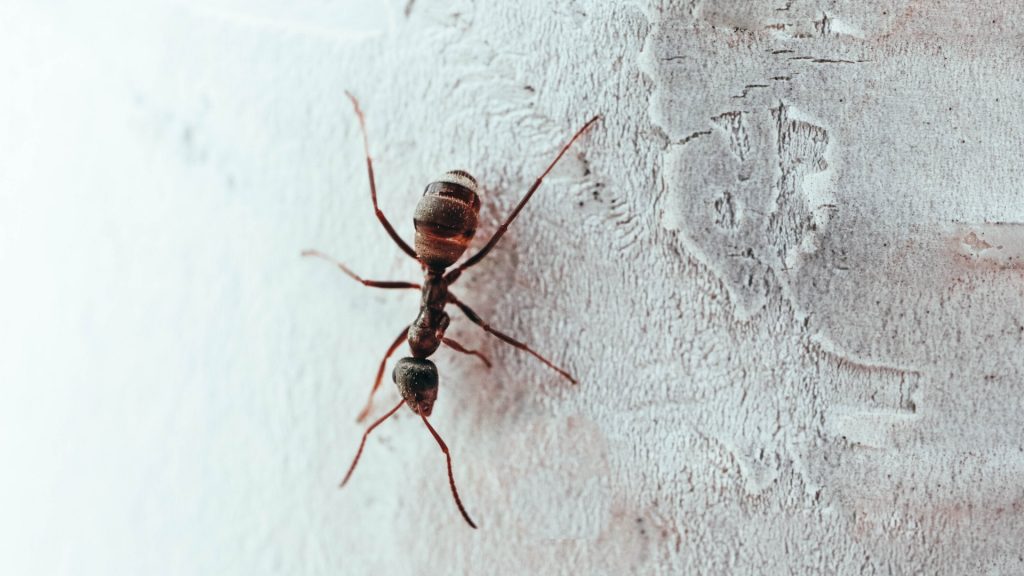
Argentine ants (Linepithema humile) can be found mainly in the southeastern part of the USA. They are similar in size and behavior with the odorous house ant. They are mainly prevalent in regions with wetter environments.
- Identification: Small ants that are 1/16 to 1/14 inches in size. They have one, pointed petiole and lack a stinger. They are reddish brown in color which darkens at the tip of their gasters.
- Nesting Site: Underneath plants, under stones or boards, and along sidewalks, preferably near a food source.
- Behavior: When crushed, they produce a musty scent, which is distinguishable from the odorous house ant’s rotten coconut odor.
- Control: Insecticides, specifically liquid or granular baits, are proven effective in controlling these ants. Broad-spectrum insecticide sprays can also be used but caution should be exercised.
Pavement Ants
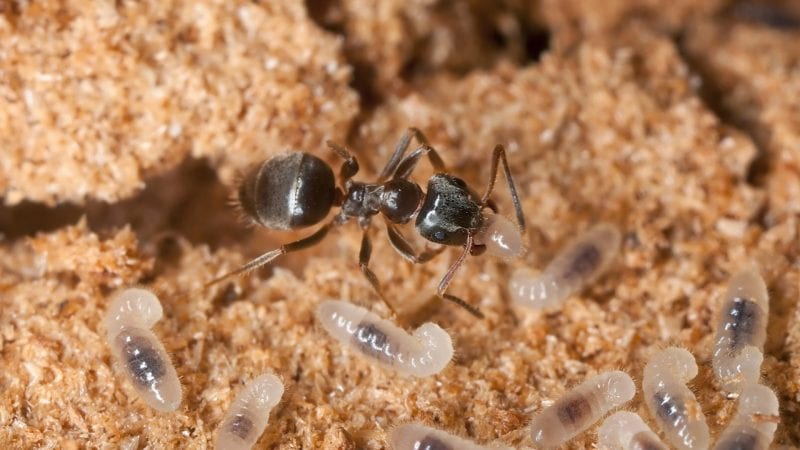
Pavement ants (Tetramorium caespitum) are major pests in upper Midwestern United States. They get their names from their habit of nesting under driveways, pavements, and sidewalks. They are usually found outdoors but can still be great nuisances.
- Identification: Medium to large-sized ants that are up to ⅛ inches in length. They are dark brown to black in color with a pair of spines on its thorax and grooves on its head.
- Nesting Site: Under stones, boards, wood, or in lawns. They also build nets along sidewalks, neat foundations, and in baseboards.
- Behavior: Their trails can often be spotted at night. They move deliberately slow and are not easily disturbed. During the spring, colonies tend to fight each other.
- Control: Boric acid and protein baits can easily attract these ants. Granular insecticides should be used for those colonies found under slabs and sidewalks.
List of Sources
Carroll, K., & Dale, A. (2021). Argentine Ant.
Cochran, S. (2015). Crazy Ant Identification Resources.
Hahn, J. (2020). Ants.
Iowa State University. (2022). Pavement Ant.
Layton, B. (2015). Tawny Crazy Ant Control Recommendations.
Liesch, P. J. (2021). Odorous House Ants.
Merchant, M. (n.d.). Identifying household ants.
Merchant, M. (n.d.). Texas Leaf Cutting Ant.
Merchant, M., & Puckett, R. (2018). Rover Ant.
Nickerson, J. C., Harris, D. L., & Fasulo, T. R. (2021). Pharaoh Ant.
Potter, M. F. (2018). Ant Control for Householders.
Rust, M. K., & Choe, D. H. (2012). Ants Management Guidelines.
Saarinen, E. V. (2017). Acrobat Ant.
Shetlar, D., Bloetscher, B., Andon, J. (2013). Ants In and Around the Home.
Wang, C., & Hamilton, G. (n.d.). Carpenter Ants and Their Control.
- Bed Bug Surge 2025: How to Detect, Prevent, and Safely Eliminate Infestations in Top U.S. Cities - June 18, 2025
- Asian Needle Ants Invade US Homes: 2025 Guide to Identification, Risks, and Effective Control - June 11, 2025
- New World Screwworm Alert: How US Livestock Owners Can Prevent Outbreaks and Protect Herds [Summer 2025 Update] - June 8, 2025

